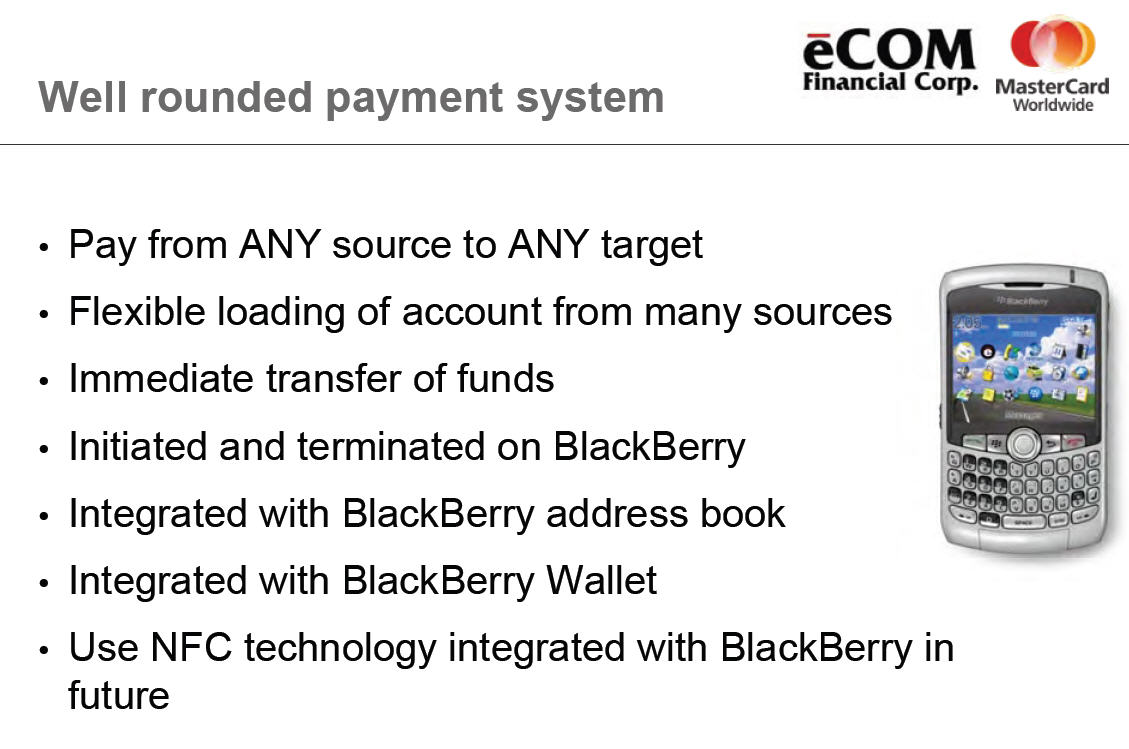My blogs will be getting shorter.. quite a busy month. I’ve been very quiet on RIM and Mastercard and thought it was time to speak up for a group with a good plan and great leadership. Facts:
- MA just hired Mung-Ki Woo from Orange to lead mobile
- MA has abandoned Obopay (Obopay set to announce VMT integration in next few weeks)
- RIM is the only handset manufacture with a card partnership. MA has announced RIM partnership in Sept 2010
- Original MA proposal to RIM was from now defunct eComm Financial. (eComm’s assets are TBD, but my guess is that MA has acquired them)
- RIM has announced NFC plans for handsets this year
- RIM has 3 core assets not held by competitors: corporate server, “push/PIN” messaging and a hardened secure architecture with military grade encryption
- RIM has failed in business leadership with its own “app world”
- RIM’s user demographic is unbeatable..
- Mastercard is 5 years ahead of Visa on contactless and in NFC.
My theory is that RIM may have a unique way to get to market and circumvent ISIS in the US. Keep your eyes peeled for anything surrounding the TSM for RIM. If RIM and MA are smart (and they are) they will work to design a TSM as an extension to RIM’s existing PIN messaging architecture (secure).
BlackBerry PIN-to-PIN (sometimes referred to as Peer-to-Peer) messaging is similar to e-mail in that it allows BlackBerry device users to send messages to each other, but with important differences:
A “PIN” is a hardware address, similar to a computer network adapter’s MAC address, and is unique to every BlackBerry device. A “PIN” is not an authentication password nor is it a user identifier. It is the method by which the BlackBerry device is identified to the RIM relay for the purpose of finding the device within the global wireless service providers’ networks.
In this relay service RIM has a global directory of BBs, IMEI/PIN, MNO provider, BES Server, eMail, … and hence the “ability” to directly message customers and for customers to message each other (independent of contracts and BES service PIN limitations).
What all this means is that if RIM puts the ISO 14443 radio on the phone, it doesn’t need the standard NFC/SWP architecture… it has the facilities for OTA provisioning and secure applications separate from a UICC. Carriers will not be in a place to dictate phone architecture to RIM as they are procured directly by governments, and corporatations.. For example, the US government should prefer this architecture, as it gives the handset owner and BES provider control over who is the “TSM” in a quasi NFC context.
This keeps it all very simple for Mastercard, as they can roll out PayPass in Blackberry without MNO support… For banks.. this means that RIM/Mastercard may be the only way for you to put contactless IN a phone (Stickers are your only other option). The Google Android ecosystem is somewhat disadvantaged here:
- They are heavily depending on ISIS MNOs for distribution
- They are not in control of handset hardware architecture
- No OTA provisioning alternative (like RIM’s PIN Relay)
Lets see if RIM and MA can pull off the business execution.
– Tom
